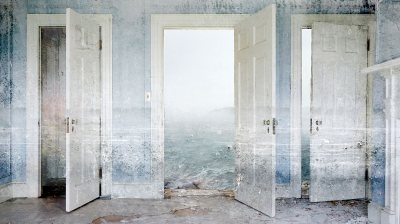
The View Out His Window (and in his mind’s eye):
Photographs by Jeffery Becton
The Bates Museum of Art invites your museum to participate in the national tour of The View Out His Window (and in his mind’s eye): Photographs by Jeffery Becton. The exhibition opens at Bates College November 6, 2015 – March 26, 2016, and is available until the end of 2017.
Jeffery Becton is a photographer and image-maker who lives on Deer Isle, a rocky and forested island off the coast of Maine. Becton makes work, in part, about his surroundings. The extraordinary sweeping coastal views that are such a part of daily life when one lives by the sea are often incorporated into his images. Equally critical is internal life, both the space inside the home (and the comfort and protection it provides from northern New England’s inclement weather), and the introspective and contemplative space that enlivens one’s imagination, which is no doubt encouraged in this stunning and remote location.
Becton makes rather than takes images. Beginning in the early 1990s—technological light years ago—he began experimenting with digital montage, creating images by fusing visual information from photographs, and scans of and from paintings, drawings and other materials into his compositions. Over the years, the subtlety and complexity of his imagery and ideas has evolved along with a fluid inventiveness and mastery of digital processes. To create this work, reproduced in this publication, he photographed, painted, layered, fused, and altered digital imagery from myriad sources, and then seamlessly constructed pictures that combine hyperreal detail, highly improbable views, and the unexplainable. In these sublime and illusory images, Becton shares this imagined and altered view from his Down East island home, while inviting us into the mysterious world in his mind’s eye.
Becton’s imagery has become increasingly strong and complex, and it has gained considerable attention in New England in recent years. Many of the extraordinary works in this exhibition will be the largest he has created. The View Out His Window will introduce Becton’s work to a national audience, along with the accompanying large format hardcover book, Jeffery Becton: The Farthest House (2015), which is the exhibition catalogue.
The exhibition is curated by Bates Museum of Art Director Dan Mills.
All works are digital montages realized as archival pigment prints
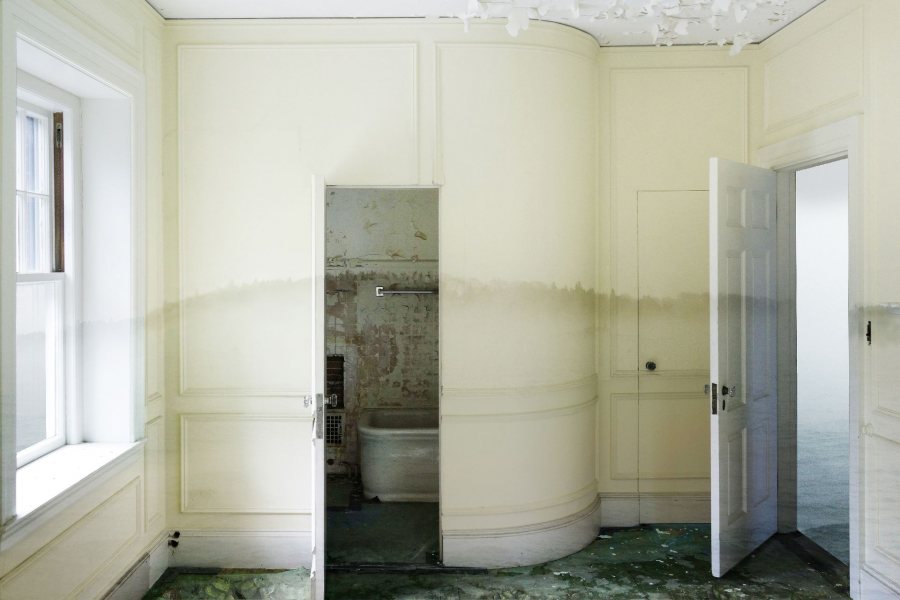
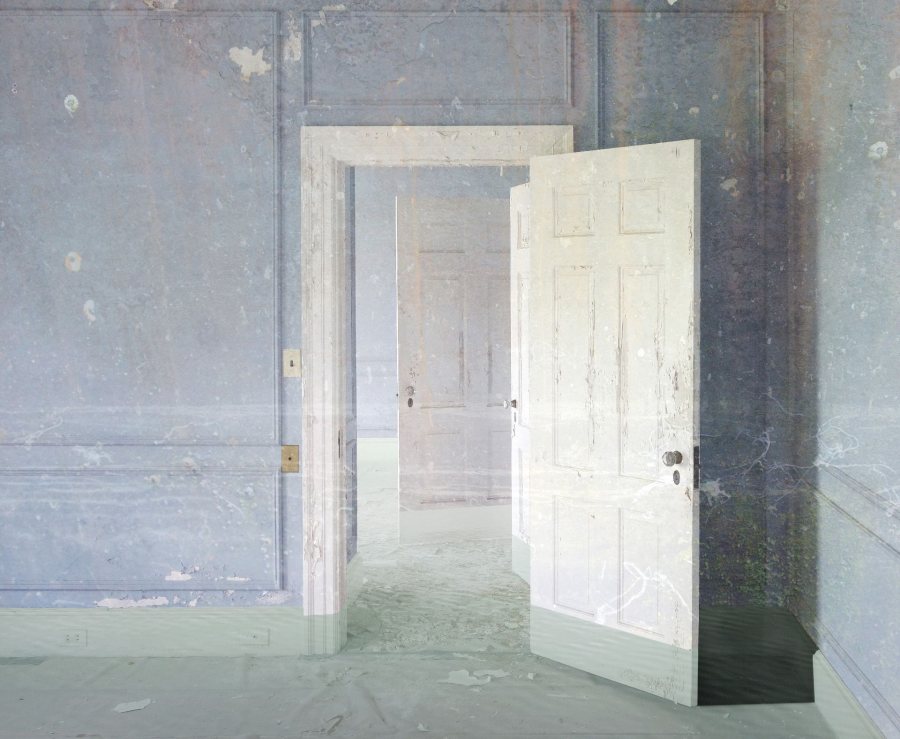
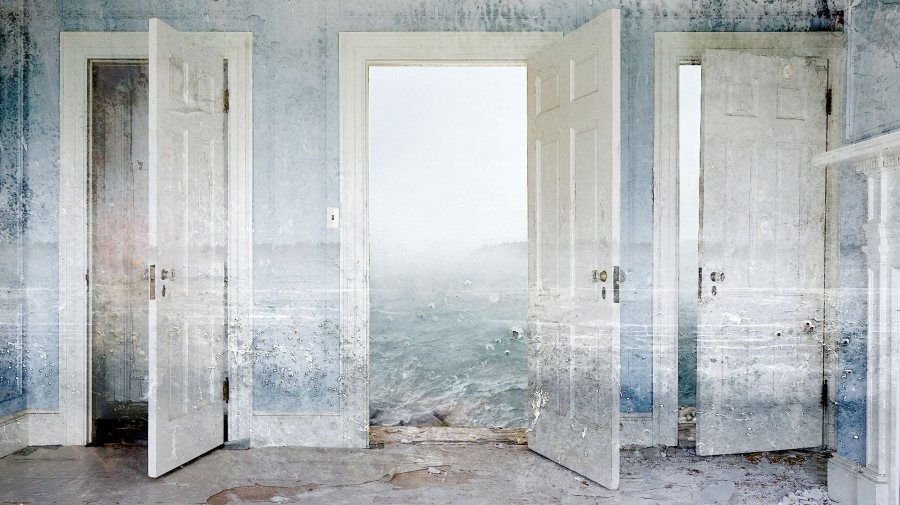
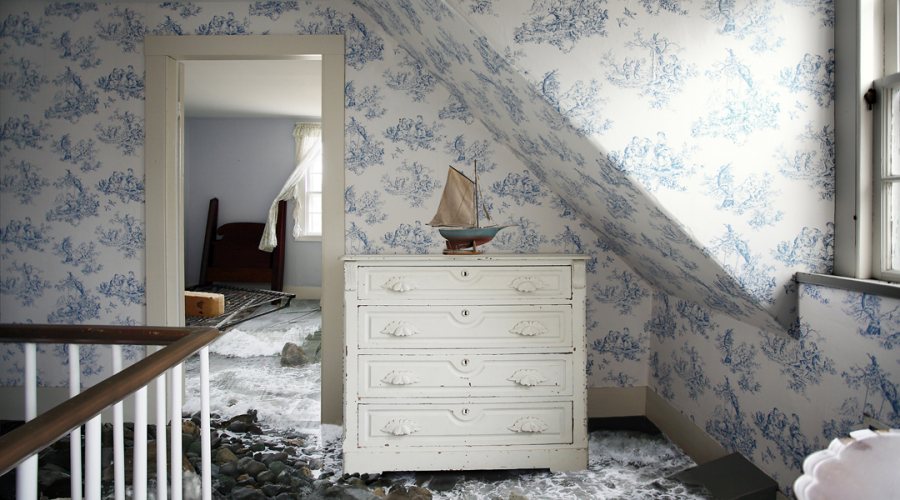
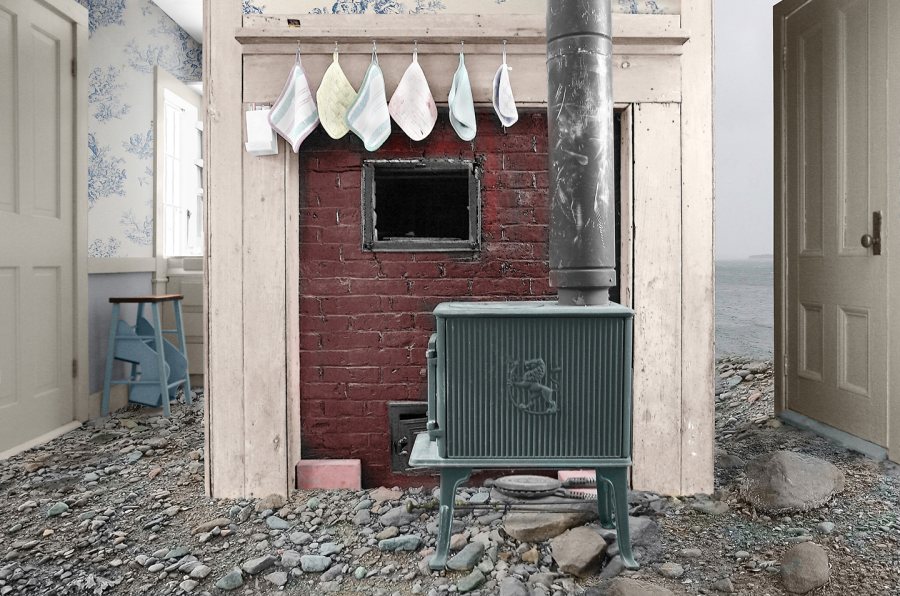
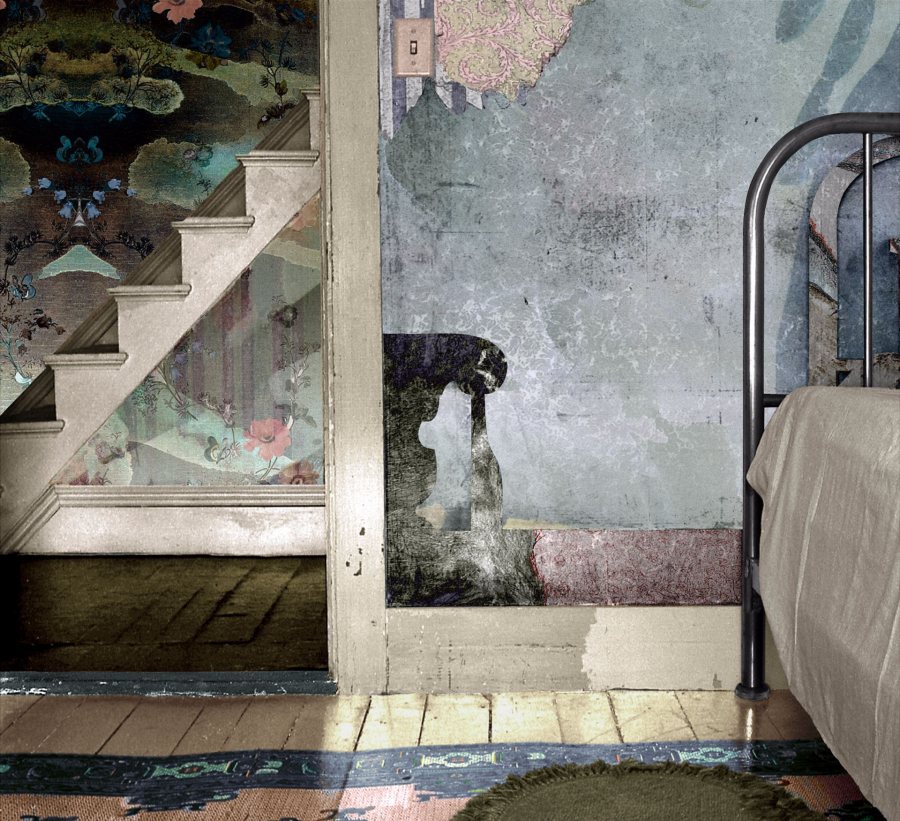
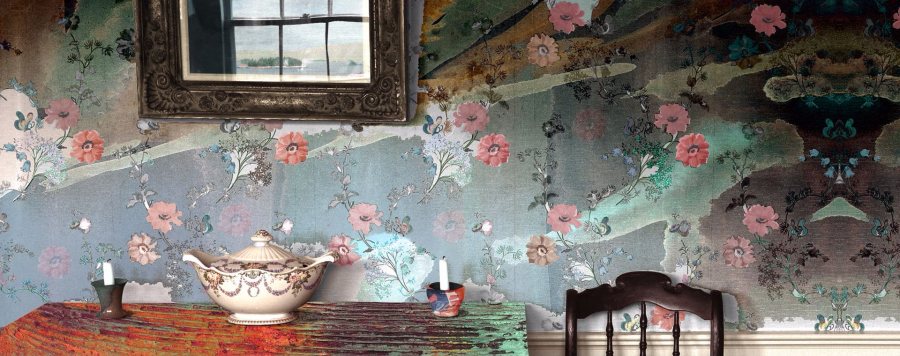


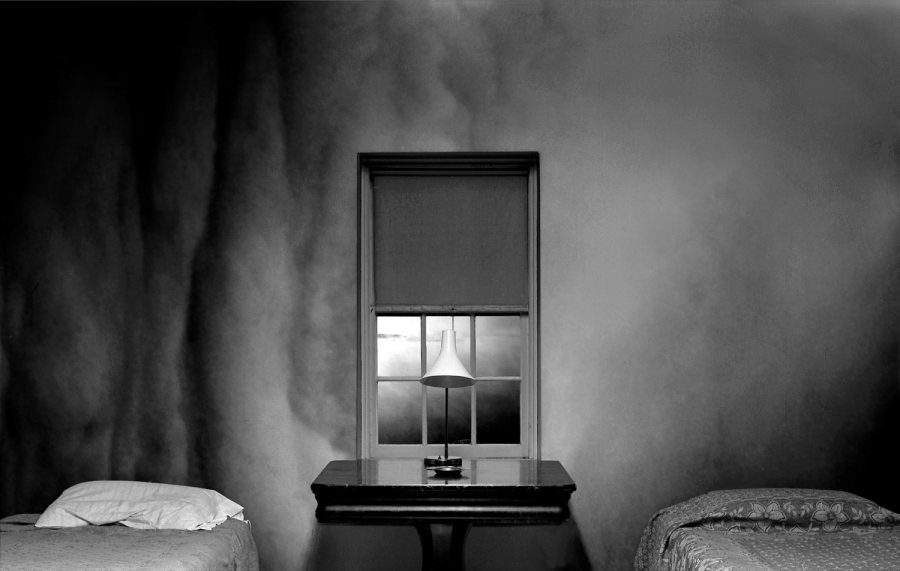
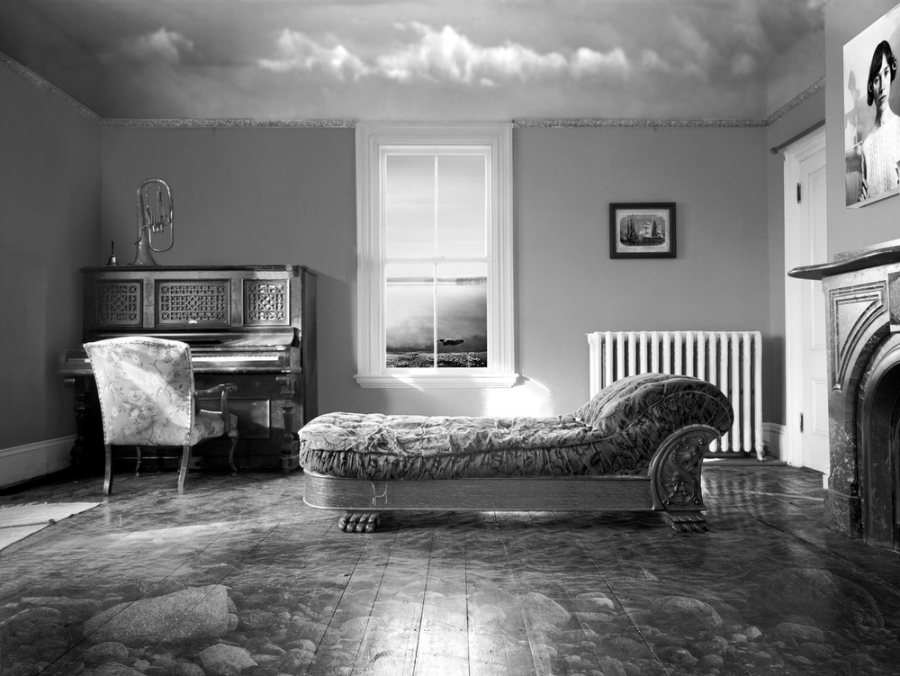
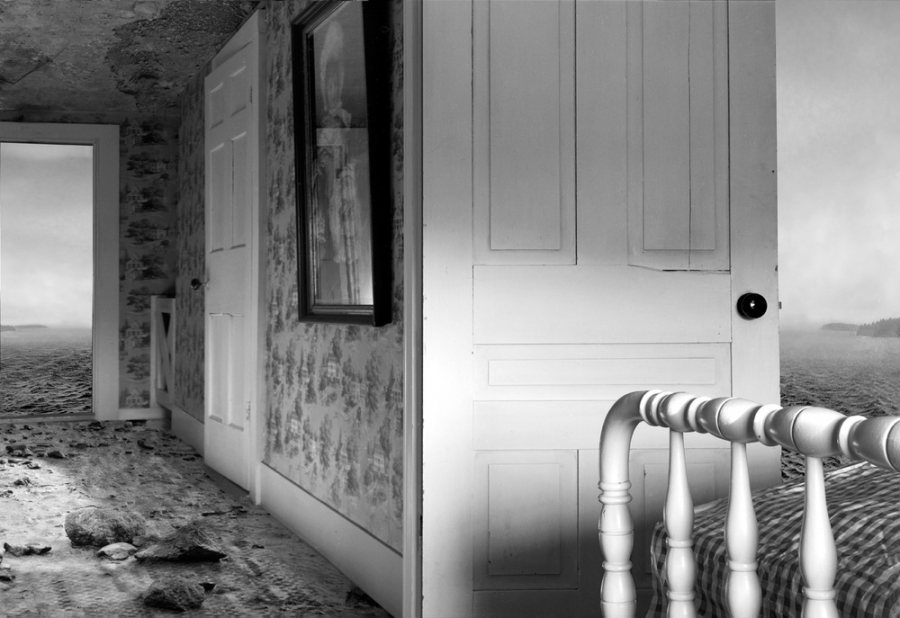
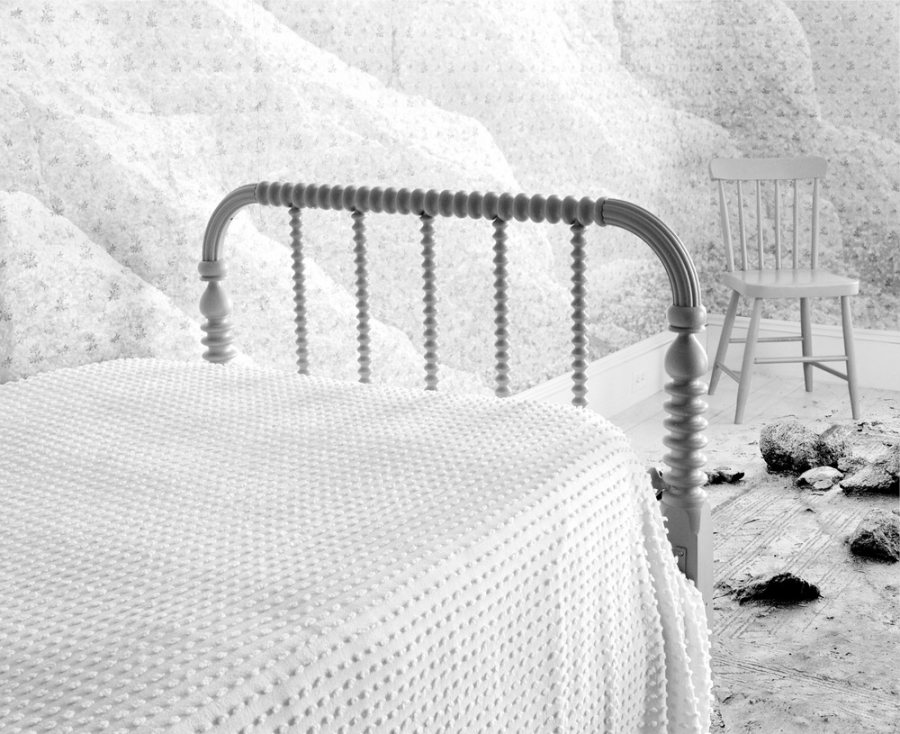
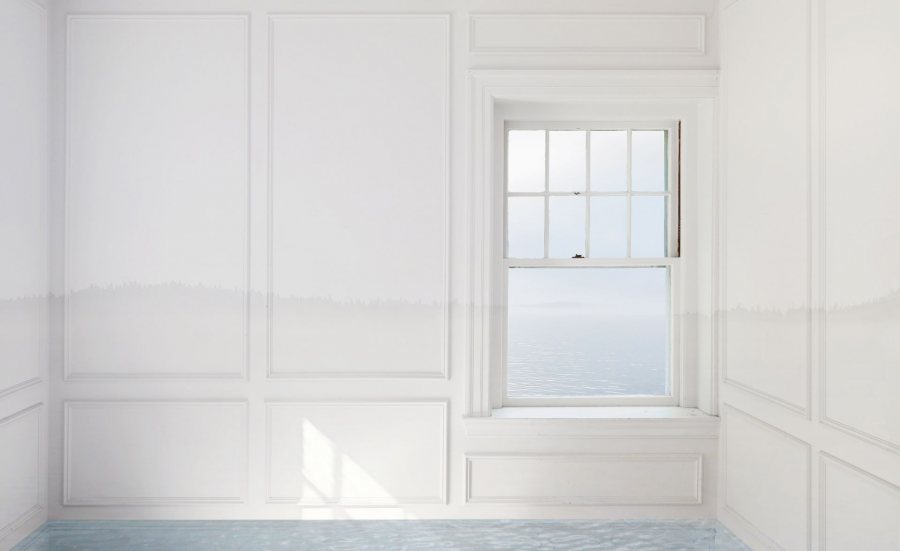
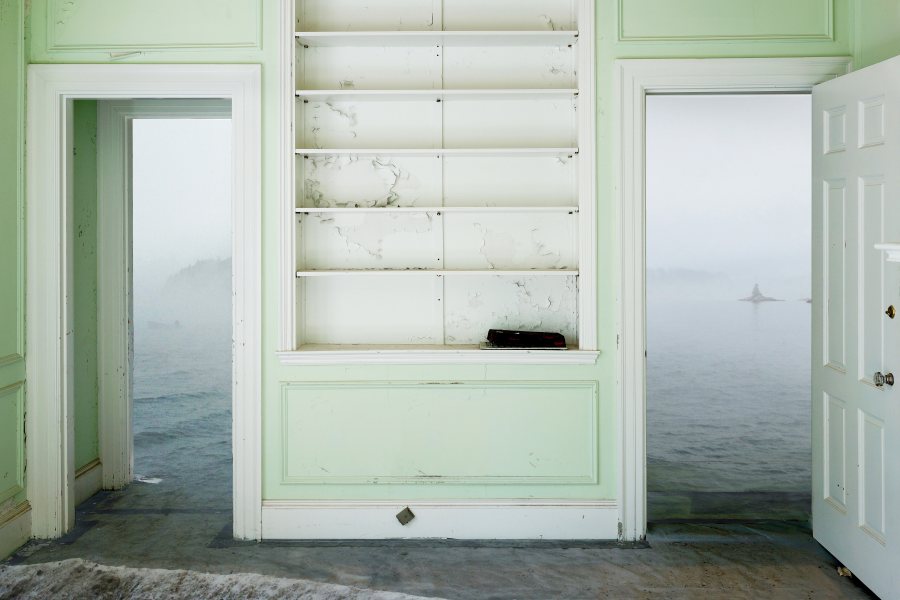
EXCERPTS FROM JEFFERY BECTON: THE FARTHEST HOUSE
I’ve always been drawn to the water. I like to be out on it as much as possible. The thing I like best is to just be out there.
–Jeffery Becton
They are photographs, and they are not. Despite knowing better, we want to believe what we see in them. Becton’s seductive elegance and his assured sense of formal control encourage credulity, even though we understand their impossibility, even though it is clear that what we are looking at is a photographic hallucination. Becton’s works are meditations on ambivalence: digital montages, beautiful and unsettling mashups, altered realities.
– Deborah Weisgall
Barnacles one expects to see attached to a ship’s hull or onto tidal rocks live on the pale walls of empty rooms and float in the atmospheric vistas seen through an open door. Waves crest upon beach pebbles improbably situated under the angles of a Cape’s second floor, where they lap at the feet of lonely furnishings. Becton’s images are amalgamations, inversions of interior and exterior, they are places where disparate elements such as crustaceous marine life, thickly painted brushstrokes, and cirrus wisps and mackerel skies exist inside, outside, above, and below.
– Dan Mills
Some might say “surreality,” as in Salvador Dalí’s famous description of his pictures as “hand painted dream photographs.” Becton flips this, by making what could be called “hand photographed dream paintings.” This distances his from the lower levels of Surrealism that depend on weirdness, and into a level of pictorial beauty that’s both locally grounded (there’s nowhere else Becton’s source material could have come from than the Maine he loves) and near-universally appreciable.
– Peter Plagens
Among Becton’s aesthetic kin one must count the Surrealists—in particular, perhaps, Magritte, who liked to mess with our grasp of the landscape. One might also make a connection to the Edward Hopper painting Rooms by the Sea (1951), in which the waters of Cape Cod Bay come right up to the door of the artist’s Truro studio. Of course, Becton brings the ocean into his houses, thereby conjuring the tidal and porous nature of our existence.
Becton’s compositions also have a place in the trompe-l’oeil tradition, although I would argue that his immaculate images move far beyond fooling the eye. They subvert perception by drawing us into an out-of-the-ordinary universe that makes perfect sense. We may be disconcerted by the flooded floor of an adjoining room, but we enter it nonetheless.
– Carl Little
SPECIFICATIONS
Itinerary:
The View Out His Window opens at Bates Museum of Art November 6, 2015 – March 26, 2016. The exhibition will travel through Fall, 2017.
Contents:
The exhibition includes 24 images, 12 medium format (ca. 20 x 30 inches) and 12 large format (proportions vary widely; 30 x 45 and 24 x 86 inches are a few examples). All images are digital montages realized as archival pigment prints. The work is framed and crated for travel. A sample press release, exhibition labels, checklist/insurance list, and introductory text panel will be provided digitally.
Space Requirements:
The exhibition requires approximately 175 linear feet, and 2,000 square feet.
Security:
Medium. Secure galleries; museum or gallery attendants must be present at all times, with medium light levels. A Facilities Report and Certificate of Insurance will be required.
Catalogue:
Each venue receives 40 copies of the hardcover book Jeffery Becton: The Farthest House (2015), which is the exhibition catalogue. Published by Courthouse Gallery in Ellsworth, Maine, the large format (12 ½ x 10 ¼ inch) 108 page book is authored by Carl Little, with contributions by Dan Mills, Peter Plagens, and Deborah Wesigall. Profusely illustrated with photographs in the exhibition and many other related works. (See contributor bios below) The book retails for $40.
Donation:
Jeffery Becton is donating a medium format work to each participating institution (est. $3,000 value).
Fee:
$4,500 for up to 10 weeks + one-way prorated transportation via fine art movers, insurance while at your institution and door-to door to the next venue. The Museum of Art is able to offer a fairly modest participation fee due to the support of anonymous donors (the art donation and catalogue values are $4,600). Venues interested in extending the exhibition may do so on a pro-rated basis ($625 per week).
Please feel free to contact me to discuss the exhibition and booking dates. Thank you. Dan Mills dmills@bates.edu 207.786.6259
Downloadable exhibition prosepctus
BIOGRAPHY
Jeffery Becton was born in Englewood, New Jersey in 1947. He received a BA in History from Yale in 1970, and MFA in graphic design from the Yale School of Art (now Yale School of Art and Architecture) in 1976. Becton moved to Deer Isle, a rocky and forested island off the coast of Downeast Maine in 1978. Since 1990, he has been creating digital montages. Becton has had solo exhibitions in museums and galleries throughout Maine, most recently, A Singularity of Place at the Maine Museum of Photographic Arts in Portland. Becton’s work has been included in many group exhibitions in Maine, New England and New York State, including at the Copley Society of Art in Boston, Munson Williams Proctor Institute in Utica, NY, and several exhibitions at both the Portland Museum of Art and Center for Maine Contemporary Art. His images have been reproduced in numerous photography and design journals, most notably Nash Editions: Photography and the Art of Digital Printing (2007), and his work is in collections including the Farnsworth Museum of Art, New Orleans Museum of Art, Portland Museum of Art, University of Maine Museum of Art, and University of New England.
JEFFERY BECTON: THE FARTHEST HOUSE CONTRIBUTORS
Carl Little is the author of Edward Hopper’s New England, Eric Hopkins: Above and Beyond, William Irvine: A Painter’s Journey and other books. He edited Art of Katahdin and contributed to Art in Maine: Contemporary Perspectives (2015). He writes for Art New England, Island Journal, Maine Boats, Homes & Harbors and Ornament.
Little has written essays for museum and gallery exhibitions and lectures widely. He helped produce film portraits of Dahlov Ipcar, Beverly Hallam, Stephen Pace, Joseph Fiore, and Jon Imber and is featured in “Richard Estes: My Camera Is My Sketchbook.” His poetry appears in Ocean Drinker: New & Selected Poems and three anthologies edited by Wesley McNair.
A native New Yorker, Little moved to Mount Desert Island in 1989. He holds degrees from Dartmouth, Columbia, and Middlebury. He directed the Blum Gallery at College of the Atlantic before joining the Maine Community Foundation in 2001.
Since the mid 1980s, Dan Mills has curated diverse and wide-ranging projects that have been presented at dozens of museums and universities throughout the US. He has contributed to numerous catalogues, on the work of Jay Bolotin, Agnes Denes, Lewis deSoto, and Xiaoze Xie, and group exhibitions including Tale Spinning and Regeneration: Contemporary Chinese Art from China and the US. He exhibits extensively, including recent solo shows at George Billis Gallery in New York, the Chicago Cultural Center, and Zolla/Lieberman Gallery in Chicago. In 2009, Perceval Press published The US Future States Atlas by Dan Mills. Mills is a frequent lecturer, critic, juror, and guest curator, and is an officer of the Association of Academic Museums and Galleries. He has directed academic museums since the mid-nineties, and has been Director of the Bates College Museum of Art since 2010.
Peter Plagens is a painter who’s shown with the Nancy Hoffman Gallery in New York since 1974, and was also art critic for Newsweek (1989-2003). His work was the subject of a retrospective in 2004-2005 at the Fisher Museum at the University of Southern California, in Los Angeles; the exhibition traveled to Columbia College in Chicago, and the Butler Institute of American Art in Ohio. He has received fellowships from the John Simon Guggenheim Foundation (painting), the National Endowment for the Arts (painting, art criticism), The Andy Warhol Foundation / Creative Capital (arts writing) and the National Arts Journalism Program. Plagens is the author of two books of art criticism—Sunshine Muse: Art on the West Coast, 1945-70 and Moonlight Blues: An Artist’s Art Criticism—as well as a novel, Time for Robo. His online novel, The Art Critic, was published as an e-book by Hol Art Books in 2012, and his monograph, Bruce Nauman: The True Artist, was published by Phaidon, in May, 2014. Currently, he writes a bi-weekly art-review column for The Wall Street Journal. He lives in New York City with his wife, the painter Laurie Fendrich.
As a journalist and cultural observer, Deborah Weisgall has written about the visual arts, literature, music, architecture, and dance for the New York Times, as well as for many other national publications, including The Atlantic, Esquire, Fortune, and The New Yorker. For the Times, she has reported on subjects ranging from dissention among Picasso’s heirs, to the New York City Ballet and to the Maine Print Project. She has also published two novels, Still Point, about dancers, and The World Before Her, about the life of the writer George Eliot, as well as a memoir, A Joyful Noise, about growing up in a family or musicians. A lifelong summer resident of Maine, she has a deep connection to Maine art and a special interest in its institutions and artists.